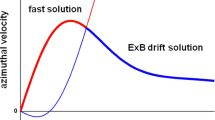Abstract
A new model of electronic vortices in plasma is studied. The model assumes that the profile of the Lagrangian invariant I, equal to the ratio I=Ω/n of the electronic vorticity to the electron density, is given. The proposed approach takes into account the magnetic Debye scale r B ≃B/4πen, which leads to breakdown of plasma quasineutrality. It is shown that the Abrikosov singular model cannot be used to describe electron vortices in plasmas because of the fundamental limitation on the electron vorticity on the axis of a vortex in a plasma. Analysis of the equations shows that in the model considered for the electronic vorticity, the total magnetic flux decreases when the size r 0 of the region in which I≠0 becomes less than c/ωpe (ωpe is the electron plasma frequency). For ω pe r 0/c≪1, an electronic vortex is formed in which the magnetic flux decreases as r 20 and the inertial component predominates in the electronic vorticity. The structure arising as ω pe r 0/c⇒0 is a narrow “hole” in the electron density, which can be identified from the spectrum of electromagnetic waves in this region.
Similar content being viewed by others
References
A. A. Abrikosov, Zh. Éksp. Teor. Fiz. 32, 1442 (1957) [Sov. Phys. JETP 5, 1174 (1957)].
O. Buneman, Proc. R. Soc. London, Ser. A 215, 346 (1952).
S. I. Braginskii, Reviews of Plasma Physics, Vol. 1 (edited by M. A. Lenotovich), Consultants Bureau, New York, 1963 [Russian original, Atomizdat, Moscow, 1963, Vol. 1, p. 183].
D. Cribier, B. Jacrot, L. M. Rao, and B. Farnoux, Phys. Lett. 9, 106 (1964).
U. Essmann and H. Träuble, Phys. Lett. A 24, 526 (1967); Phys. Status Solidi 20, 95 (1967).
A. S. Kingsep, K. V. Chukbar, and V. V. Yan’kov, Topics in Plasma Theory [in Russian], Énergoatomizdat, Moscow, 1987, Vol. 16, p. 209.
A. A. Abrikosov, Fundamentals of the Theory of Metals, North-Holland, Amsterdam, 1988 [Russian original, Nauka, Moscow, 1987].
A. V. Gordeev, Preprint N 5928/6, RRC “Kurchatov Institute,” Moscow, 1995.
A. V. Gordeev, Fiz. Plazmy 23, 108 (1997) [Plasma Phys. Rep. 23, 92 (1997)].
A. V. Gordeev and S. V. Levchenko, in 18th Symposium on Plasma Physics and Technology, Prague, June 17–20, 1997, pp. 74–76.
S. V. Bulanov, M. Lontano, T. Zh. Esirkepov et al., Phys. Rev. Lett. 76, 3562 (1996).
V. D. Shafranov, Reviews of Plasma Physics, Vol. 3 (edited by M. A. Lenotovich), Consultants Bureau, New York, 1967 [Russian original, Atomizdat, Moscow, 1963, Vol. 3, p. 3].
Author information
Authors and Affiliations
Additional information
Pis’ma Zh. Éksp. Teor. Fiz. 67, No. 7, 461–466 (10 April 1998)
Rights and permissions
About this article
Cite this article
Gordeev, A.V., Levchenko, S.V. Is the Abrikosov model applicable for describing electronic vortices in plasmas?. Jetp Lett. 67, 482–488 (1998). https://doi.org/10.1134/1.567714
Received:
Issue Date:
DOI: https://doi.org/10.1134/1.567714



